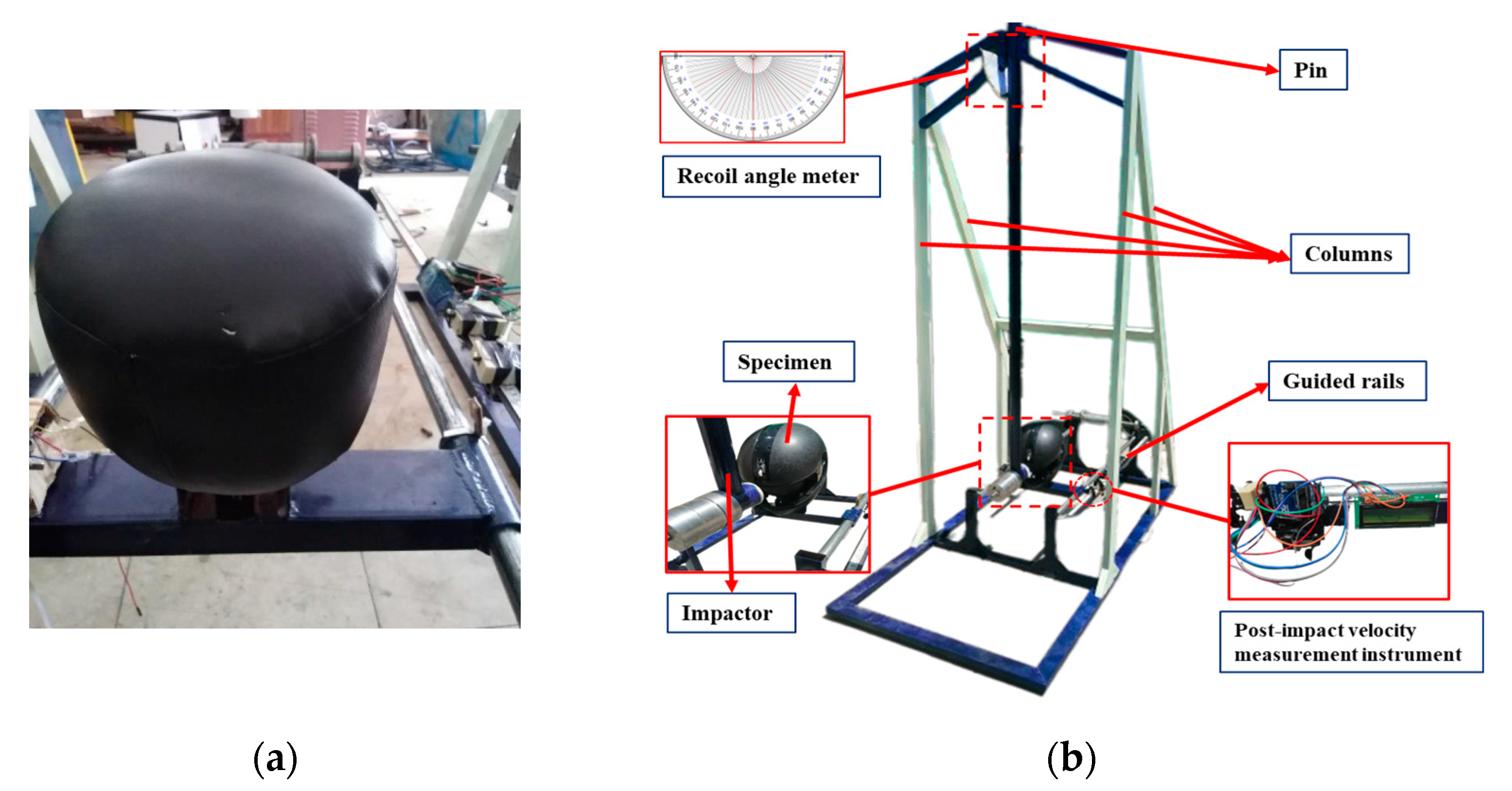A Novel Low-Cost Machine for Evaluating Helmet Performance in Bike Accident Scenarios †
Abstract
:1. Introduction
2. Materials and Methods
2.1. Design of Column
2.2. Design of Impactor Arm
2.3. Impact Duration Measurement
2.4. Measurement of Energy Absorbed by Helmet
3. Results and Discussion
4. Conclusions
Author Contributions
Funding
Institutional Review Board Statement
Informed Consent Statement
Data Availability Statement
Conflicts of Interest
References
- Critchley, G.; Memon, A. Epidemiology of Head Injury. In Head Injury: A Multidisciplinary Approach; Cambridge University Press: Cambridge, UK, 2009; pp. 1–11. [Google Scholar] [CrossRef]
- Kongwat, S.; Nueanim, T.; Hasegawa, H. FE Analysis of Motorcycle Helmet Performance under Severe Accidents. Appl. Sci. 2022, 12, 5676. [Google Scholar] [CrossRef]
- Ali, H.; Mustansar, Z.; Talay, S.; Masood, A.; Zahoor, S.; Sherbaz, S. Time-Dependent Analysis and Classification of Deformation Mechanism in Head Impact Injury Using Image Based Finite Element Method (FEM). In Proceedings of the 2021 12th International Conference on Mechanical and Aerospace Engineering, ICMAE 2021, Athens, Greece, 16–19 July 2021; Institute of Electrical and Electronics Engineers Inc.: Piscataway, NJ, USA, 2021; pp. 576–581. [Google Scholar]
- Whyte, T.; Stuart, C.A.; Mallory, A.; Ghajari, M.; Plant, D.J.; Siegmund, G.P.; Cripton, P.A. A Review of Impact Testing Methods for Headgear in Sports: Considerations for Improved Prevention of Head Injury Through Research and Standards. J. Biomech. Eng. 2019, 141, 070803. [Google Scholar] [CrossRef] [PubMed]
- Mills, N.J.; Gilchrist, A. Oblique Impact Testing of Bicycle Helmets. Int. J. Impact Eng. 2008, 35, 1075–1086. [Google Scholar] [CrossRef]
- Bhudolia, S.K.; Gohel, G.; Subramanyam, E.S.B.; Leong, K.F.; Gerard, P. Enhanced Impact Energy Absorption and Failure Characteristics of Novel Fully Thermoplastic and Hybrid Composite Bicycle Helmet Shells. Mater. Des. 2021, 209, 110003. [Google Scholar] [CrossRef]

| Component | Material |
|---|---|
| Column | Mild Steel (Both ends fixed) |
| Specimen (bike helmet) | Glass Fiber (E = 72 GPa) |
| Impactor (variable mass range of 5–20 kg) | Mild Steel (E = 200 GPa) |
| Instruments used | IR Sensor, Limit Switch, Timer |
| Guide Rails | Stainless steel (E = 190 GPa) |
| Sr. No | 1 | 2 | 3 | 4 | |
|---|---|---|---|---|---|
| Before Impact attributes of impactor | Angle of lift (degree) | 30 | 45 | 60 | 75 |
| Height attained (m) | 0.245 | 0.536 | 0.914 | 1.355 | |
| Velocity just before impact (m/s) | 2.19 | 3.24 | 4.23 | 5.15 | |
| Total energy (J) | 24.01 | 52.53 | 89.57 | 132.79 | |
| Impact Duration (s) | 0.13 | 0.23 | 0.35 | 0.4 | |
| Post Impact attributes of impactor | Impactor recoil angle (degree) | 10 | 15 | 20 | 24 |
| Height attained (m) | 0.028 | 0.062 | 0.11 | 0.16 | |
| Recoil energy (J) | 2.744 | 6.076 | 10.78 | 15.68 | |
| Post Impact attributes of helmet | Distance travelled by helmet (m) | 0.18 | 0.27 | 0.3 | 0.33 |
| Kinetic energy of helmet (J) | 3.70 | 5.56 | 6.17 | 6.79 | |
| Energy absorbed by helmet (J) | 17.56 | 40.89 | 72.62 | 110.32 | |
Disclaimer/Publisher’s Note: The statements, opinions and data contained in all publications are solely those of the individual author(s) and contributor(s) and not of MDPI and/or the editor(s). MDPI and/or the editor(s) disclaim responsibility for any injury to people or property resulting from any ideas, methods, instructions or products referred to in the content. |
© 2023 by the authors. Licensee MDPI, Basel, Switzerland. This article is an open access article distributed under the terms and conditions of the Creative Commons Attribution (CC BY) license (https://creativecommons.org/licenses/by/4.0/).
Share and Cite
Abbas, S.M.; Ali, H.; Naqvi, S.A.A.; Iqbal, M.; Jabbar, H.H.; Azeem, M.; Masud, M. A Novel Low-Cost Machine for Evaluating Helmet Performance in Bike Accident Scenarios. Eng. Proc. 2023, 45, 39. https://doi.org/10.3390/engproc2023045039
Abbas SM, Ali H, Naqvi SAA, Iqbal M, Jabbar HH, Azeem M, Masud M. A Novel Low-Cost Machine for Evaluating Helmet Performance in Bike Accident Scenarios. Engineering Proceedings. 2023; 45(1):39. https://doi.org/10.3390/engproc2023045039
Chicago/Turabian StyleAbbas, Syed Mujahid, Haider Ali, Syed Aqib Ali Naqvi, Mohsin Iqbal, Hafiz Hamza Jabbar, Muhammad Azeem, and Manzar Masud. 2023. "A Novel Low-Cost Machine for Evaluating Helmet Performance in Bike Accident Scenarios" Engineering Proceedings 45, no. 1: 39. https://doi.org/10.3390/engproc2023045039
APA StyleAbbas, S. M., Ali, H., Naqvi, S. A. A., Iqbal, M., Jabbar, H. H., Azeem, M., & Masud, M. (2023). A Novel Low-Cost Machine for Evaluating Helmet Performance in Bike Accident Scenarios. Engineering Proceedings, 45(1), 39. https://doi.org/10.3390/engproc2023045039






